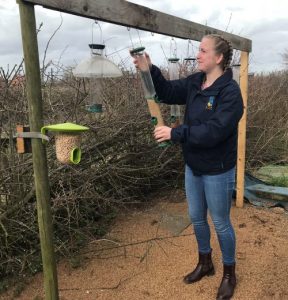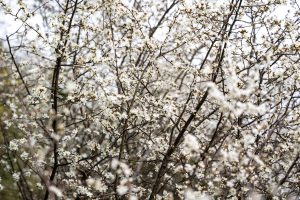A new face on the Farm
Our newest staff member, Jen Orrell, discusses the benefits of interacting with nature, as well as what you can do to get more nature in your life.
When I first started at Vine House Farm, the first thing I did was take part in a farm tour with owner, Nicholas Watts MBE. Standing in the middle of the fen, breathing in the fresh air whilst surrounded by bird song, filled me with joy and tranquillity. In an increasingly technology-orientated world, it was a pleasure to switch off and hear about the vast conservation work that happens here, as well as the contribution Vine House Farm makes to The Wildlife Trusts.
More and more people are recognising how vital green spaces like this are to us. The benefits of being more connected to nature are endless, and it has been proven in several studies that it improves both our physical and mental health. For those living in areas with high levels of deprivation and with associated poor health, the advantages of getting closer to wildlife are even more noticeable.
Having worked on projects focusing on physical and mental health in some of the most deprived wards in Peterborough, I have seen first hand the benefits of people increasing their access to nature. An example is someone who was scared even to leave the house, but by being involved in a project growing organic vegetables, it gave him the confidence to get out and meet other people in his area. Everyone’s experience is different and in urban areas like this, spaces like community gardens can provide a welcome break from the hustle and bustle of the city, whilst increasing fitness, expanding social connections and improving well-being.
In 2014 the Institute of Health Equity released a report stating that “on average people living in greener urban areas were happier than when they lived in areas with less urban greenery”. This highlights that accessibility to nature can be an issue, however there are small steps many of you can take to get closer to wildlife, whether you have a garden or not:
Jen Orrell
When I first started at Vine House Farm, the first thing I did was take part in a farm tour with owner, Nicholas Watts MBE. Standing in the middle of the fen, breathing in the fresh air whilst surrounded by bird song, filled me with joy and tranquillity. In an increasingly technology-orientated world, it was a pleasure to switch off and hear about the vast conservation work that happens here, as well as the contribution Vine House Farm makes to The Wildlife Trusts.
More and more people are recognising how vital green spaces like this are to us. The benefits of being more connected to nature are endless, and it has been proven in several studies that it improves both our physical and mental health. For those living in areas with high levels of deprivation and with associated poor health, the advantages of getting closer to wildlife are even more noticeable.
Having worked on projects focusing on physical and mental health in some of the most deprived wards in Peterborough, I have seen first hand the benefits of people increasing their access to nature. An example is someone who was scared even to leave the house, but by being involved in a project growing organic vegetables, it gave him the confidence to get out and meet other people in his area. Everyone’s experience is different and in urban areas like this, spaces like community gardens can provide a welcome break from the hustle and bustle of the city, whilst increasing fitness, expanding social connections and improving well-being.
In 2014 the Institute of Health Equity released a report stating that “on average people living in greener urban areas were happier than when they lived in areas with less urban greenery”. This highlights that accessibility to nature can be an issue, however there are small steps many of you can take to get closer to wildlife, whether you have a garden or not:
- Our window feeders are a great alternative for those who aren’t lucky enough to have a garden of their own to encourage nearby birds. Use the suction cups to attach one to the outside of your window and wait and see what turns up!
- In the summer, the Ordnance Survey released a free layer of their online maps, helping people to find their nearest greenspace as part of their campaign to encourage people to #GetOutside more. Find a place and either get exploring on your own or with a friend or family member.
- If you don’t have an area outside for plants, there are many indoor plants that you can grow instead. For example, you can easily grow a spider plant from a cutting, so ask around and see if a friend has one you can trim.
- Learn more about wildlife friendly farming and what we’ve been doing most recently at our farm in Lincolnshire by reading our latest blog and signing up to our newsletter at the bottom of this page.
- There are many groups and organisations working hard to make green spaces and wildlife more accessible for people with different requirements and needs. For example, if mobility is an issue then it is worth checking out Disabled Ramblers online who list their own organised walks as well as useful websites to help you find a walk that is wheelchair or buggy friendly.
- According to a report by the University of Derby on behalf of the RSPB, young children that interact with wildlife have significantly higher English attainment. To get them outside and interested in the natural world around them try these fun activity sheets from the Wildlife Trust.
Jen Orrell



